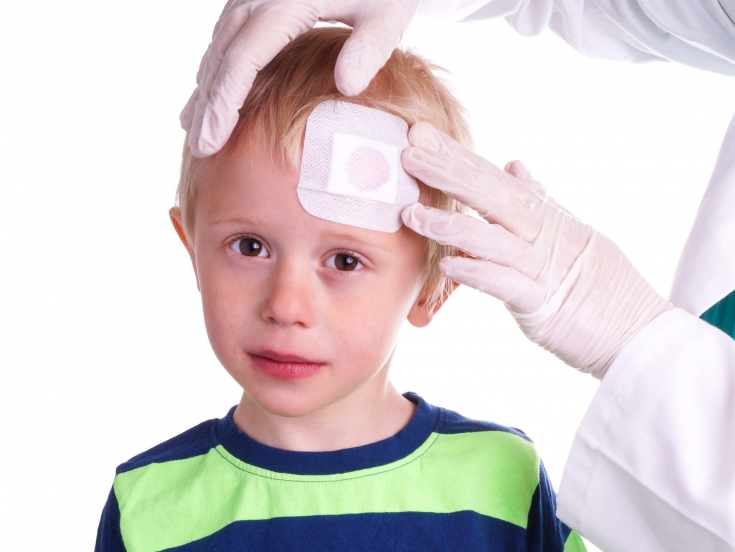Winter – this is not only a wonderful time for children to go sledding, but also a period of injuries sustained on ice. Someone, falling, injures his knees, and someone – arms. However, most often in young children there is a head injury. Despite the fact that it may be accompanied by only slight abrasions, it still needs to be taken extremely seriously. Indeed, when hitting the head, the substance of the brain can be damaged and even slight bleeding occurs in the cranial cavity. How to help a child if he suddenly slipped and hit his head, you can learn from the article by Evgeny Komarovsky "Head Injury: Emergency Care" or by reading the tips we have prepared based on the recommendations of Dr. Komarovsky.
Why children are more susceptible to injury than adults
Children's head injury – the phenomenon is not rare. Why is this happening? It's all about physiology. If in an adult the skull is strong enough, then in children in the first years of life the skull is not yet strong enough. Despite the fact that the fontanelles located on the top and back of the head soften the blows, this does not completely protect the child from injury.
Even a minor injury can be dangerous for a very tiny baby. It can lead to serious consequences. Therefore, in any case, you should consult a doctor.
Most common types of head injuries
In order to understand how to deal with a head injury, it is necessary to know the main symptoms of such a problem. As stated in the article "Head Injury: Emergency Care", they are different and differ depending on the type of injury. Below we will consider the types of trauma that are often found among children:
• Concussion – the most common injury. Many experts in the field of medicine suggest that during a concussion, the brain substance is shaken, and the organ itself hits the bones of the skull from the inside. At this time, the brain cells do not interact well with the brain regions, but there is no damage to the brain tissue as such. A concussion in a child occurs with a small number of symptoms. The presence of such an injury is indicated by nausea, vomiting, pallor, lack of appetite, sleep disturbance.
• Contusion of the brain – this is a more dangerous injury, since in this case the substance of the brain is damaged, accompanied by swelling and intracranial bleeding.
• Compression of the brain. When the brain tissue flows, and hematomas occur inside the skull, this often leads to compression of the brain. This is a very dangerous condition because it can lead to respiratory and circulatory disorders.
• Tranio-cerebral injury – serious injury that combines a concussion, contusion and compression of the brain. Such an injury can be either closed or open. In the first case, the bones of the skull remain intact, and in the second case, their integrity is violated. An open craniocerebral injury can also be penetrating, when the dura mater, located between the inside of the skull and the medulla, is damaged. Here, in addition to nausea and vomiting, other symptoms appear: headache, dizziness, loss of consciousness, blood from the nose and ears.
• Head injury. Such an injury is not as dangerous as the previous ones, since only soft tissues are damaged here and there are no such unpleasant symptoms as dizziness and nausea.
• Head injury. Such an injury is not as dangerous as the previous ones, since only soft tissues are damaged here and there are no such unpleasant symptoms as
dizzinessand nausea.
In the first case, the bones of the skull remain intact, and in the second case, their integrity is violated. An open craniocerebral injury can also be penetrating, when the dura mater, located between the inside of the skull and the medulla, is damaged. Here, in addition to nausea and vomiting, other symptoms appear: headache, dizziness, loss of consciousness, blood from the nose and ears.• Head injury. Such an injury is not as dangerous as the previous ones, since only soft tissues are damaged here and there are no such unpleasant symptoms asdizziness
located between the inside of the skull and the medulla. Here, in addition to nausea and vomiting, other symptoms appear: headache, dizziness, loss of consciousness, blood from the nose and ears.  and nausea.
and nausea.
If the head injury is minor, you can help your child on your own by calming him down, laying him down on the bed and applying ice cubes to the damaged area.
Despite the fact that the head injury is minor, it is still necessary to observe your child in the first 24 hours after the injury. After all, the symptoms of a dangerous injury may not show up immediately.
But if the injury is serious, medical attention is indispensable here. Call an ambulance in the following cases: • loss of consciousness;
• severe and prolonged headache;• dizziness;• repeated bouts of vomiting;
• bleeding from the nose and ears;
• dark blue spots under the eyes and behind the ears;
• hearing impairment;
• constant drowsiness;
•& runny nose after crying;• convulsions.
"Regardless of the symptoms present, seeking medical attention is necessary if a head injury is sustained while intoxicated or under the influence of drugs," says Dr. Komarovsky. "Dangerous symptoms may not appear immediately, so parents should carefully monitor the child as for at least 24 hours after a head injury, even if the injury appears to be minor."






Add a comment